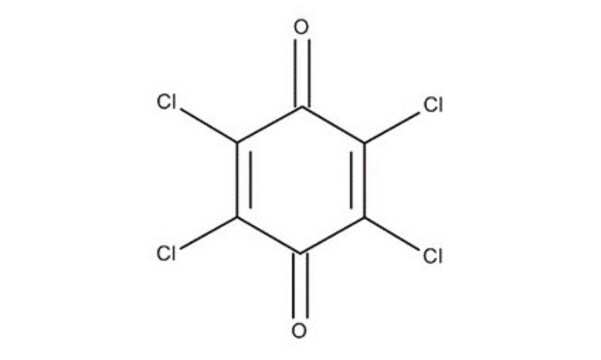Wichtige Dokumente
C8136
Chloranilsäure
≥98%
Synonym(e):
2,5-Dichlor-3,6-dihydroxy-2,5-cyclohexadien-1,4-dion, 2,5-Dichlor-3,6-dihydroxy-p-benzochinon, NSC 6108, NSC 97383
About This Item
Empfohlene Produkte
Qualitätsniveau
Assay
≥98%
Form
powder
mp (Schmelzpunkt)
≥300 °C (lit.)
SMILES String
OC1=C(Cl)C(=O)C(O)=C(Cl)C1=O
InChI
1S/C6H2Cl2O4/c7-1-3(9)5(11)2(8)6(12)4(1)10/h9,12H
InChIKey
IPPWILKGXFOXHO-UHFFFAOYSA-N
Suchen Sie nach ähnlichen Produkten? Aufrufen Leitfaden zum Produktvergleich
Anwendung
- Acting as a proton donor in reactions studying dimensionality control
- Synthesis of dimethylbipyridyl complexes
- Synthesis of (nonylbenzimidazolylmethyl)benzene for preparation of neutral altitudinal rotor-shaped dirhenium metallacycles
- Charge-transfer reactions with metoprolol tartrate
- Salt formation with organic bases
- Synthesis of osmium metalla-rectangles with anticancer activity
Signalwort
Warning
H-Sätze
Gefahreneinstufungen
Eye Irrit. 2 - Skin Irrit. 2 - STOT SE 3
Zielorgane
Respiratory system
Lagerklassenschlüssel
11 - Combustible Solids
WGK
WGK 3
Flammpunkt (°F)
Not applicable
Flammpunkt (°C)
Not applicable
Persönliche Schutzausrüstung
dust mask type N95 (US), Eyeshields, Gloves
Hier finden Sie alle aktuellen Versionen:
Besitzen Sie dieses Produkt bereits?
In der Dokumentenbibliothek finden Sie die Dokumentation zu den Produkten, die Sie kürzlich erworben haben.
Kunden haben sich ebenfalls angesehen
Unser Team von Wissenschaftlern verfügt über Erfahrung in allen Forschungsbereichen einschließlich Life Science, Materialwissenschaften, chemischer Synthese, Chromatographie, Analytik und vielen mehr..
Setzen Sie sich mit dem technischen Dienst in Verbindung.

